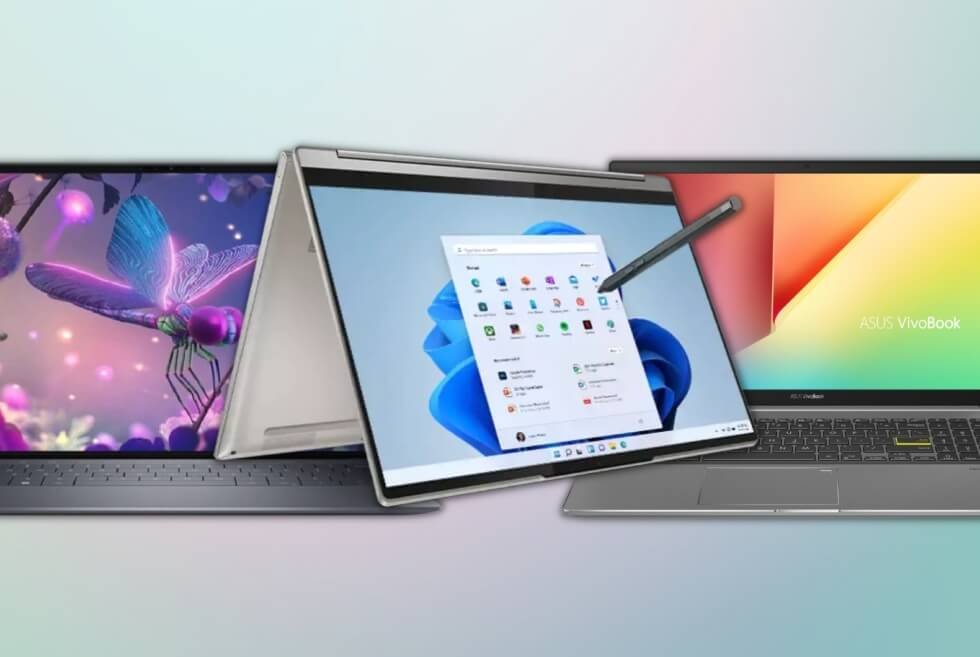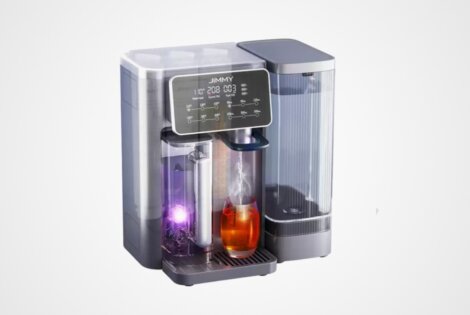Contents
It’s no great secret that Apple makes some of the best computers on the market.
Though they’re not exactly gaming-friendly, the MacBooks are known to be the “everyman” computer, the one-size-fits-most solution for professionals and work-from-home freelancers alike.
But boy, does that price tag sting!
You won’t find a newer-model MacBook with a price tag under $1,000, and though the full suite of software and functions available on the MacBook definitely are worth the cost, it may be too steep an investment for many who just don’t have an extra grand laying around their house.
Thankfully, Apple has many competitors who are more than happy to undercut their =prices, even if they can’t quite match up to the MacBook’s standards.
The number of laptops available on the market today are growing by the year, and you’ll find many of them are worthy rivals to even Apple’s finest.
Below, we’ll share with you the best MacBook alternatives you can find today. They compete with the MacBook in terms of pricing, specs, functionality, and versatility, even portability and light weight.
Read over this list of the top alternatives to consider, and see if one of them will suit your needs—and your budget—better than a MacBook.
But first, check out our complete buyer’s guide to finding a worthy rival to MacBook…
A Look at the MacBook Specs
To understand what makes a computer a worthy MacBook alternative, you need to know what you’re getting when you buy a MacBook.
Let’s start off by looking at the most important specs in a MacBook. We’re going to look at their most affordable model, which is the MacBook Air.
Price: $999
Display: 13.3-inch (diagonal) LED-backlit display with IPS technology; 2560-by-1600 native resolution at 227 pixels per inch with support for millions of colours, with resolution from 1680 x 1050 down to 1024 x 6401
Chip: Apple M1 chip, 8-core CPU with 4 performance cores and 4 efficiency cores, 7-core GPU, 16-core Neural Engine
Battery/Power: 15 hours of battery life from the 49.9-watt hour lithium-ion battery
Memory: 8 GB unified memory (expandable up to 16 GB)
Storage: 256 GB solid-state drive (expandable up to 2 TB)
Camera: 720p FaceTime HD camera
Weight: 2.8 pounds
Why MacBook?
There are a number of reasons that people choose MacBooks over Windows or Linux laptops:
- Stylish and trendy – Yes, no doubt about it, Apple just makes better-looking laptops than most of their rivals, and it’s very trendy to own a MacBook (even if it’s more computer than you really need). Plus, it pairs perfectly with your iPhone, the most commonly owned smartphone in the Western world currently.
- Portability – Compared to the average laptop, the MacBook Air is significantly lighter. Even the MacBook Pro weighs less than the much bulkier offerings of laptops by Dell, HP, Lenovo, and Samsung.
- User-Friendly OS – For those who have spent their lives using Windows computers, sure, it can be a bit tricky to learn the MacOS. However, young people who have grown up on the iPhone often find MacOS more intuitive and easier to use than Windows. Plus, Apple provides a ton of resources to help master their operating system, even providing one-on-one training sessions.
- Sleeker and Speedier – There’s no doubt about it: even the latest Windows versions just can’t compete with macOS for speedy functionality. Everything about it, from the operating system itself to the apps it runs, are faster-paced and utilize less of the computer’s resources.
- Greater Security – The vast majority of the world uses Windows computers, which means the vast majority of computers targeted by cyber-criminals are, you guessed it, Windows computers. Given that Windows is one of the primary systems utilized by developers, it’s crafted with software development in mind. macOS, on the other hand, isn’t as developer-friendly, and there is less system information available to anyone attempting to access the computer externally. Thus, it’s less vulnerable to cyber-attacks.
- More Upgrades – Apple is constantly evolving its chip sets and processors to ensure that their latest models run as fast and efficiently as possible. The fact that they develop everything in-house (rather than relying on third-party providers, such as AMD or Intel like Windows computers do) means they have greater control over quality and functionality of the computer’s hardware.
At the end of the day, there’s no denying that even the base MacBook is a worthy work computer, one that can be used by professionals in a wide range of industries. It’s particularly useful for anyone working in a creative industry—from musicians to artists to designers to engineers.
However, the price tag is a huge factor that gives people pause when computer-shopping. Also, there are a lot of programs designed specifically—and only—for Windows that are used in certain industries, which makes MacBooks less-than-ideal for anyone working in those industries.
What to Look for in a MacBook Alternative
If you’re seriously considering a MacBook alternative, you need to know what to look for. As you’ve seen by the specs above, there are certain “standards” you’ll want to meet or exceed—or, at the very least, come “close enough” to rival.
Here are the most important factors to take into account when looking for a MacBook alternative:
Size
The MacBook Air comes with a screen 13.3 inches across, though you can find larger models (there are 14 and 16-inch Pro models available). The computers are designed to be ultra-portable, so it’s no surprise that they feel a bit on the smaller side. That being said, they’re easy enough to slip into any backpack or briefcase, and more and more compact bags are being designed around the slim, compact shape of MacBook Airs.
So, one factor to consider when shopping for a MacBook alternative is a similar size—not just width and height, but also thickness. That way, you can fit your computer into the same stylish bag you’d carry a MacBook Air around in.
Weight
A computer that weighs just 2.8 pounds is a very light computer, indeed! The larger-model MacBook Pros weigh a bit more, but the increase isn’t huge.
Compare that to the weight of your average gaming computer, and you can see a significant difference. Let’s take, for example, the HP Pavilion Gaming Laptop. The laptop sells for roughly the same price tag as the MacBook Air, though it’s got a bigger screen (15 inches vs. 13.3 inches). When you look at how much it weighs, though, get ready to be blown away: 4.91 pounds. That’s double the weight of the MacBook Air.
Now let’s look at sort of the budget-friendly “everyday work laptops” on the market—for example, the Lenovo ThinkPad X1. This particular laptop doesn’t pack next-level, high speed hardware, nor is it over-large with its 14-inch screen. It actually weighs less than the MacBook Air at 2.48 pounds. That means it’s even more portable than Apple’s lowest-priced option.
Display
The size of the display is a factor to keep in mind, but there’s also the quality of the display. Apple features a very pixel-dense display, with rich, vivid colors and an aspect ratio set standard at 16:10, which is the ratio recommended by most programs (even Windows programs).
Their “Liquid Retina XDR Display” features three layers—one with mini LEDs, one with optical films and diffusers, and the last with an LCD display—that makes for very high-definition quality.
There are a number of Windows computers that can match that HD quality, especially those with a higher refresh rate (above 60 Hz) and denser resolution. However, you’ll have to do some serious research to find a laptop that can offer you better image quality than a MacBook.
Speed
As you saw above, Apple has earned itself a reputation for being a very speed, agile computer, with apps that open quickly and a streamlined operating system. Windows, by comparison, often feels sluggish and bloated.
Speed is dictated by the processors (GPU and CPU), as well as the RAM and even the type of hard drive (SSD operates faster than standard SATA drives). Apple has manufactured its computers for speed, and there are few Windows computers that can keep up.
But they are out there! Intel and AMD both manufacture lightning-fast chips that can match Apple’s M1 chip set. AMD chips tend to drain less battery power, while Intel’s chips offer better performance in single- and multi-core CPUs.
Battery Life
A battery life of up to 15 hours is no joke! There are only a handful of Windows laptops that can come close to matching the lifespan of Apple’s batteries.
However, you can find a few models that offer upwards of 6 hours of battery life, some even as high as 12 hours. These will offer the same quality performance you’d get from a MacBook, just with more re-charging needed.
Build Quality
There’s no doubt that Apple leads the market in terms of build quality. Their computers may feel light, but they’re surprisingly tough and resilient. Their components are top-of-the-line and very resistant to malfunction and defect.
There are a few brands who can match Apple’s quality—among them Dell, Razer, and some Alienware models—but they often command a price even higher than the MacBook.
Gaming Performance
This is where Apple is almost always in last place! MacBooks can handle heavier applications, but they’re just not really built to be gaming computers.
For gamers, finding a computer that can handle the rigors of more CPU and RAM-intensive games is a lot easier if you search among Windows’ offerings.
Price
Last, but definitely not least, you’ll want to factor in price.
As you saw above, the MacBook Air starts at a cool $999, and just goes up from there. It’s a safe bet that there are A LOT of Windows computers that retail for a significantly lower price tag.
However, the “budget-friendly” Windows computers may not be able to match Apple’s quality or performance. If the cost of your computer is an important factor and you’re looking to save, you may have to settle for a bit less computer than you’d get with a MacBook.
Now that you know what to look for in a suitable MacBook alternative, it’s time to dive in and take a closer look at the best options for you to consider!
Best MacBook Alternatives
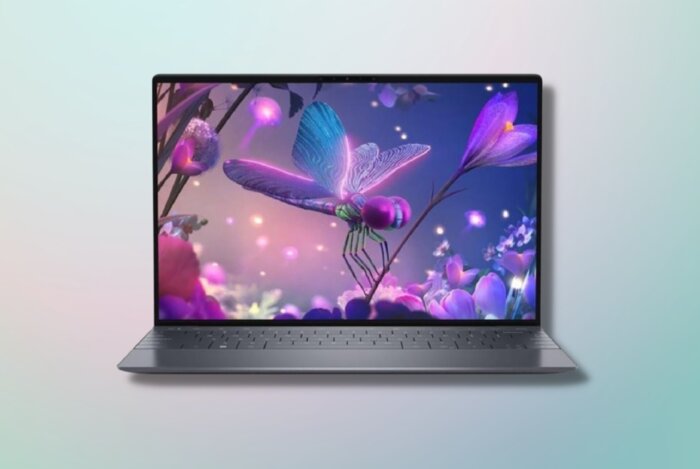
Dell XPS 13 Plus
Dell is one of the few brands that build laptops that can match the MacBook’s computing power, and their XPS 13 Plus rivals the MacBook Air in both size and weight (though it’s fractionally thicker and heavier). Featuring Core i5 or i7 processors, it’s a worthy competitor to Apple’s Ms processor, and it offers up to 2TB of storage and 32 GB of system memory.
The haptic touchpad feels and works very much like the MacBook’s, and the edge-to-edge keyboard is comfortable enough you’ll have no trouble typing on it all day long. Though it doesn’t have a 3.5mm headphone jack (like most Windows laptops do), it features two Thunderbolt 3 ports and comes with a USB-C to USB-A adaptor in the box so you can easily plug in your USB-connected headphones. The OLED panel, too, offers vivid colors and striking resolution that is a darn good match for the Apple MacBook. Considering their prices are fairly similar, any Windows-loving user will find that this is definitely one of the best MacBook alternatives, hands down.
Specs
- Screen Size: 13.4 inches
- CPU: 12th Gen Intel® Core™ i5-1240P (12 MB cache, 12 cores, 16 threads, up to 4.40 GHz Turbo)
- Weight: 2.71 lbs.
- Key Feature: Fresh, stylish design mimics the look and feel of the MacBook but stands out as highly Windows-friendly
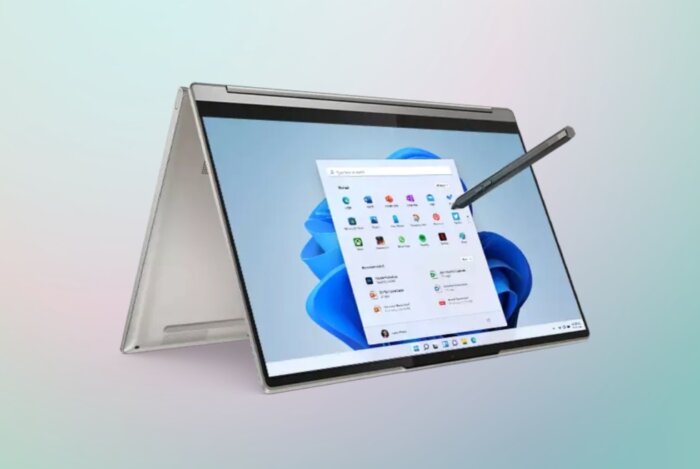
Lenovo Yoga 9i (14” Intel) 2 in 1 Laptop
If you want to keep your laptop truly slim, lightweight, and versatile, you’ll love the Lenovo Yoga 9i. The display is slightly larger than the MacBook air (14 inches vs. 13.3), and is only a few ounces heavier (3.02lbs). It runs on Intel’s EVO platform, with the Intel i7 processor that makes it ultra-speedy and capable of running more CPU-intense programs.
However, what really makes it a winner (more so than the MacBook, it could be argued) is the 2-in-1 design. The metal case can be folded backward to transform it from a laptop into a tablet (even with stand), which can be used as a touchscreen or controlled via the provided stylus. This makes it highly useful as a drawing or writing tablet, great for artists, assistants, and anyone else who wants total control over their surface.
Other great features include: Thunderbolt 4 USB ports, WiFi 6, webcam privacy shutter, fingerprint reader to add biometric security, a Dolby Atmos speaker system, 360-degree sound, Intelligent Cooling, and battery life to rival even the MacBook’s, up to 18 hours of local video playback (with the FHD display). For just a few bucks more than the MacBook, it offers a lot of truly excellent features and functionalities that make it worth the price.
Specs
- Screen Size: 14 inches
- CPU: 11th Generation Intel® Core™ i7-1195G7 Processor (2.90 GHz, up to 5.00 GHz with Turbo Boost, 4 Cores, 8 Threads, 12 MB Cache)
- Weight: 3.02lbs
- Key Feature: 2-in-1 design turns it from laptop to tablet
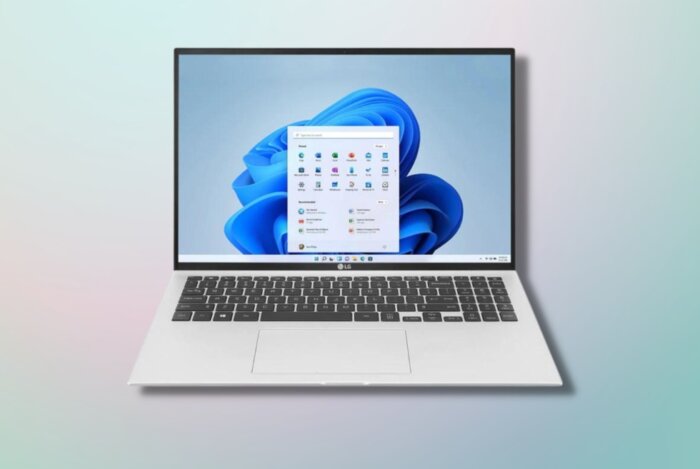
LG Gram 16
For those who want a big screen but don’t want to be burdened by a heavy computer, the LG Gram 16 is a game-changer for sure. Though the screen is the same size as the MacBook Pro (16 inches), the laptop weighs roughly the same as the MacBook Air (2.62 lbs). That makes it large enough to use for just about any work task, but light enough to carry around on your daily commute easily.
The laptop packs quite a lot of power under the hood, too: a 2 cell lithium ion 80 mAh battery that delivers up to 22 hours of battery life, Intel® Iris® Xe Graphics and a 2560 x 1600 resolution with a 16:10 display, 1TB of storage in the Solid-State Drive, 16 GB of RAM, and an i7 CPU that can run up to 4.7 GHz and has a 12 MB cache.
It’s significantly cheaper and lighter than the MacBook Pro, but delivers everything you need to work easily with ample screen space. Definitely a good alternative!
Specs
- Screen Size: 16 inches
- CPU: i7-1165G7 (2.8 GHz, Turbo up to 4.7 GHz, L3 Cache 12MB)
- Weight: 2.62 lbs
- Key Feature: Large size, but very light weight (comparable to MacBook Air)
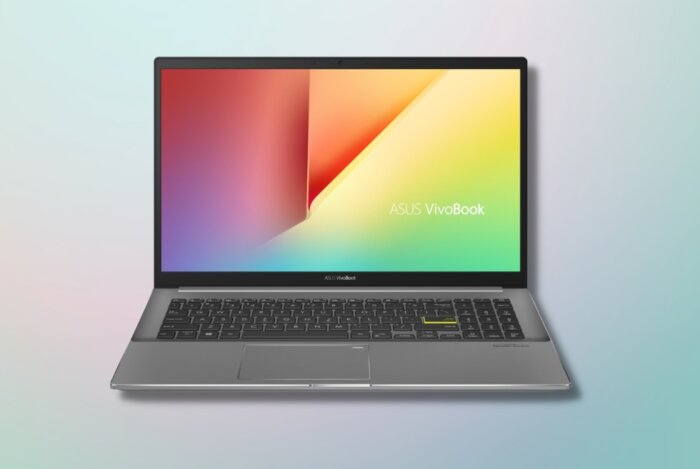
Asus VivoBook S15
If you’re looking for a cheaper, more budget-friendly alternative to Apple’s MacBook Air, the ASUS Vivobook S15 is just what you need. The price tag is significantly lower (roughly 20%!), but don’t for a minute think that it skimps on performance and versatility. The computer uses Intel’s 10th-gen i7 and i9 Core processors, with up to 16 GB of RAM and storage up to 1 TB of SSD. Best of all, it comes with a 15.6 inch screen that is a worthy rival to the 16-inch screen on the MacBook Pro, but sold at a fraction of the higher-end MacBook’s cost.
There are a couple of minor flaws: it’s not the best on battery life, and the resolution doesn’t go above 1080p, so you don’t get full, vivid HD colors and quality like you would with Apple. It’s also definitely on the heavier side—a whopping 3.97 pounds. But considering the size of its screen and the fact that it comes with the NVIDIA® GeForce® MX250 graphics card and 2 GB of dedicated video memory, you’ll see why it’s a solid option for anyone who is looking to save big on a work laptop.
Specs
- Screen Size: 15.6 inches
- CPU: 10th-generation Intel Core i7 – i9
- Weight: 3.97 pounds
- Key Feature: Extremely affordable compared to similar-sized MacBook
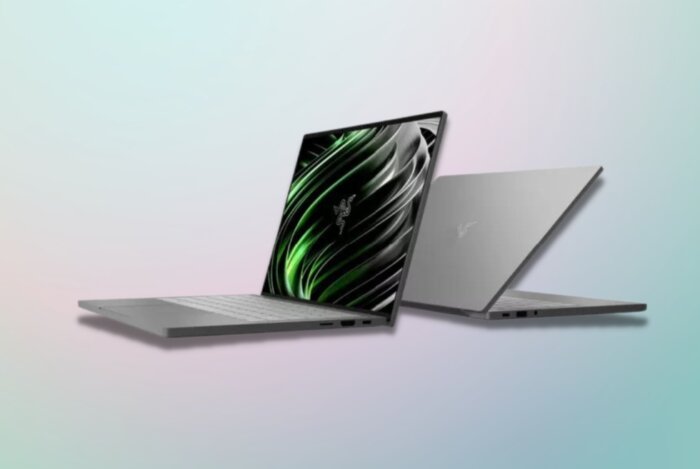
Razer Book 13
One area where MacBook just can’t compete with Windows laptops is in gaming performance. Razer, however, is one of the best-known names in the gaming world, so when they released the Razer Book 13, everyone sat up and took notice.
Fair warning: it’s not Razer’s best gaming laptop. The Book 13 has to sacrifice a dedicated graphics card in the name of keeping it slim and lightweight, so you won’t get exponentially better gaming performance than on a MacBook Air. However, it’s more than capable of handling most light-duty games thanks to its integrated Intel Core i7, and the 14-hour battery life makes it easy for you to take your gaming on the road.
Add to that two Thunderbolt 4 ports, an HDMI port, a USB-A port, a microSD card reader, and a 3.5mm headphone jack, and you can see why this is one of the best alternatives to the MacBook Air.
Specs
- Screen Size: 13.4 inches
- CPU: Intel Core i7-1165G7 4 Core
- Weight: 3.09 lbs
- Key Feature: Designed to be sleek, slim, and ultra-lightweight to rival the MacBook Air
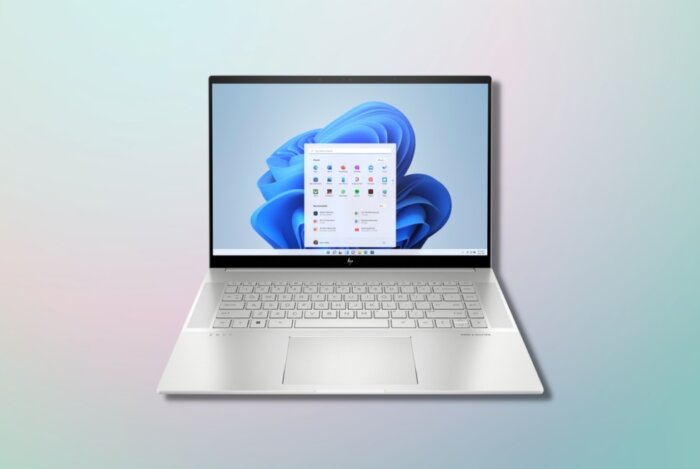
HP Envy 16
If you’re all about that computing power but don’t want to pay MacBook Pro prices, the HP Envy 16 is a truly worthy rival. It’s packed with the same 16-inch screen as the larger MacBooks, plus a whole lot of computing power—including an Intel 12th-gen 45-watt CPU, 16:10 WQXGA (2560 x 1600) IPS display at 120Hz, the Nvidia GeForce RTX 3060 graphics card, and a sharp OLED display with up to 4K resolution.
On the downside, it’s definitely much heavier than Apple’s high-end laptop. However, it more than makes up for it in performance, not to mention connectivity. It offers a microSD card reader, two Thunderbolt 4/USB-C ports, a USB-A port, and even an HDMI port. The performance is comparable to the MacBook Pro, but the price is significantly lower. For those who want a lot of power and don’t mind lugging around a bit more weight, this is the computer for you.
Specs
- Screen Size: 16 inches
- CPU: Intel 12th-gen 45-watt CPU
- Weight: 5.12 pounds
- Key Feature: Ultra-powerful, a worthy rival to the MacBook Pro, though certainly much heavier
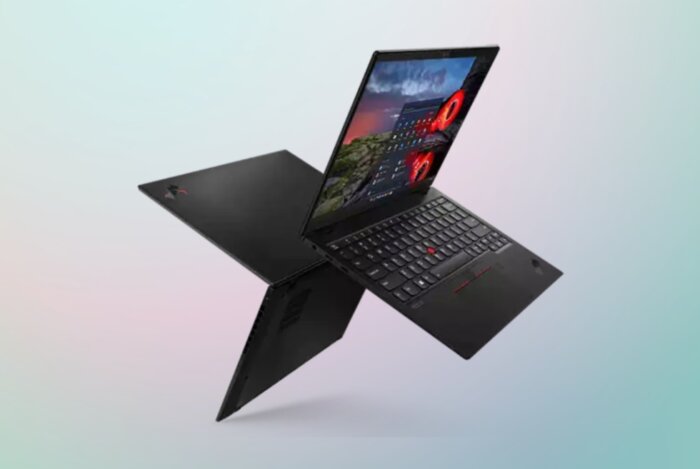
Lenovo ThinkPad X1 Nano
The MacBook Air stands out as being one of the lightest, most portable laptops on the market, but the Lenovo ThinkPad X1 Nano definitely gives it a run for its money. The 13-inch display is the same size as the MacBook Air, and you’ll find it’s equally sleek and compact. However, Lenovo wins by a wide margin in the weight—this computer clocks in at under 2 pounds, about half a pound lighter than the ultra-light MacBook Air. It’ll feel almost like carrying a tablet around town, but with all the computing power you need from a proper laptop.
Standout features of this laptop include: 2160 x 1350 display, support for Dolby Vision, Tiger-Lake Intel Core i5/i7 processors, 8GB of LPDDR4x RAM (expandable up to 16GB), a 256GB SSD, the X1 keyboard you know and love, a 16:10 display, and up to 13 hours of battery life.
It’s a challenger to the MacBook Air in every aspect that matters, though the price tag is a bit higher. But for anyone who wants a truly lightweight computer that can go anywhere and do anything, you’ll find it’s a worthwhile investment.
Specs
- Screen Size: 13 inches
- CPU: Up to 11th Gen Intel® Core™ i7-1180G7 Processor with vPro™
- Weight: 1.99 pounds
- Key Feature: Lighter and more portable than the MacBook Air
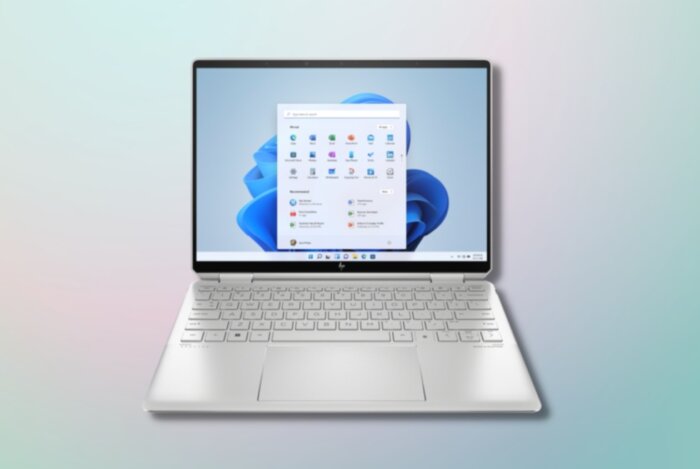
HP Spectre x360 13.5
If you liked the look of the Lenovo Yoga 2-in-1 tablet but worried it didn’t have enough power for you, you’ll love what the HP Spectre x360 13.5 has to offer. In addition to a slightly larger screen (13.5 inches), it features a 3000 x 2000 OLED display that offers truly vivid, accurate, and dynamic colors that many users actually find outperforms the MacBook. The 3:2 aspect ratio offers a more natural feel and excellent performance, too.
The base model starts with the Intel® Core™ i5-1235U and up to 4.4 GHz of RAM, but you can always opt for the faster model with the Intel® Core™ i7-1255U and up to 4.7 GHz of RAM. All of the Spectres come with the Intel® Iris® Xe Graphics card, which ensures excellent video and gaming performance. The laptops also include a solid-state drive (standard at 512 GB, but expandable up to 2 TB).
The 2-in-1 design makes this laptop a truly excellent option for artists, architects, and anyone who prefers to take notes by hand, and it looks and feels beautifully elegant while still offering versatility and functionality.
Specs
- Screen Size: 13.5 inches
- CPU: Intel® Core™ i5-1235U and up to 4.4 GHz of RAM (though can be upgraded to Intel® Core™ i7-1255U and up to 4.7 GHz of RAM)
- Weight: 3.01 pounds
- Key Feature: Heavier, more solid, faster-performing 2-in-1 laptop and tablet built for maximum versatility
Google Pixelbook Go
Google joins this list with the Pixelbook Go, one of the best Chromebooks yet to be released. While it can’t come close to offering the same power and performance as the MacBook, it’s ultra-light, versatile, and operates with the same pep that makes the macOS so beloved around the world. Plus, the keyboard is insanely comfortable for even thick-fingered users, and you’ll find it’s compact enough to fit into any bag or backpack.
A peek under the hood reveals decent offerings: Intel Core m3 – i7 CPU (depending on upgrades), an Intel UHD Graphics 615 graphics card, up to 16 GB of RAM, a 13.3-inch screen upgradable to 4K Ultra-HD resolution, and up to 256GB of storage space. The integrated webcam is also 1080p so you can enjoy video conferences and calls with crystal clarity. Best of all, the price tag is significantly lower than even the cheapest MacBook Air, and it’s easily integrated with all of Google’s other products—including Assistant, Alexa, and Home. And that 12-hour battery life is definitely nothing to scoff at.
Specs
- Screen Size: 13.3 inches
- CPU: Up to Intel Core i7
- Weight: 2 pounds
- Key Feature: Very lightweight and portable; great computer to take on any working holiday or business trip


